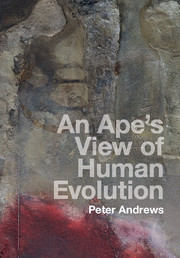Book contents
- Frontmatter
- Contents
- Preface
- 1 How can we recognize common ancestors?
- Part I Apes: their morphology and behaviour
- PART II Environments and palaeoenvironments
- Part III Review of fossil apes
- 7 The view from the early Miocene
- 8 The environment in the early Miocene
- 9 The view from the middle Miocene
- 10 Specialized apes from the middle Miocene
- 11 The environment during the middle Miocene
- 12 A second view from Europe
- 13 The environment in Europe
- 14 Late Miocene to Pleistocene apes
- 15 Apes, hominins and environment in the late Miocene
- Part IV Last common ancestor
- References and further reading
- Index
- References
8 - The environment in the early Miocene
from Part III - Review of fossil apes
Published online by Cambridge University Press: 05 January 2016
- Frontmatter
- Contents
- Preface
- 1 How can we recognize common ancestors?
- Part I Apes: their morphology and behaviour
- PART II Environments and palaeoenvironments
- Part III Review of fossil apes
- 7 The view from the early Miocene
- 8 The environment in the early Miocene
- 9 The view from the middle Miocene
- 10 Specialized apes from the middle Miocene
- 11 The environment during the middle Miocene
- 12 A second view from Europe
- 13 The environment in Europe
- 14 Late Miocene to Pleistocene apes
- 15 Apes, hominins and environment in the late Miocene
- Part IV Last common ancestor
- References and further reading
- Index
- References
Summary
The environments associated with early Miocene fossil apes are described here following the methods outlined in Chapter 6. It is important to remember that the operative word here is ‘associated’, for while the geology, plants and animals may all indicate specific habitats, it can not be known for certain that the fossil apes associated with the specific environmental evidence were actually living in these habitats. In some cases there is direct association between fossil ape and environmental evidence, for example when specimens of fossil ape are found together with plant remains, but in many cases they are found at different levels or different parts of the site, and association is inferred. However, if the fossil apes can be shown to be associated, time after time, with a particular habitat, there may be a strong presumption that they did indeed occupy that habitat.
Geological evidence
Geological evidence on the environment present at Rusinga Island has been provided by Michael Le Bas and by McCall, who described the formation of the large carbonatite volcano that was the source of the sediments on Rusinga Island (Figure 8.1): “Before the onset of Tertiary volcanism, the area has been subjected to peneplanation since the Mesozoic … there is no evidence of any derived sediments. At that time drainage was to the west and Lake Victoria did not exist.” The sediments making up the Miocene deposits on Rusinga Island consist of volcanic sandy strata, on some of which fossil soils developed. The volcano is estimated to have been a large, low relief dome up to 20 km in diameter, and the sediments on which the fossil soils formed have been dated to about 18 million years and are listed as follows, from top to bottom:
Kiangata Agglomerate: thick deposits of agglomerate and ash flow (no fossils);
Kulu Formation: finely layered lake deposits with abundant fish but few terrestrial animals;
Hiwegi Formation: tuffaceous deposits in a riparian setting with abundant fossils of plants and animals in fossil soils; flood plain deposits and debris flows;
Rusinga Agglomerate: massive deposits but no fossils;
Kiahera Formation: tuffaceous deposits with few fossils on Rusinga Island, more abundant and more fossiliferous on Mfwangano Island;
Basal fluvial gravels and overbank clayey deposits (no fossils).
- Type
- Chapter
- Information
- An Ape's View of Human Evolution , pp. 137 - 149Publisher: Cambridge University PressPrint publication year: 2016



